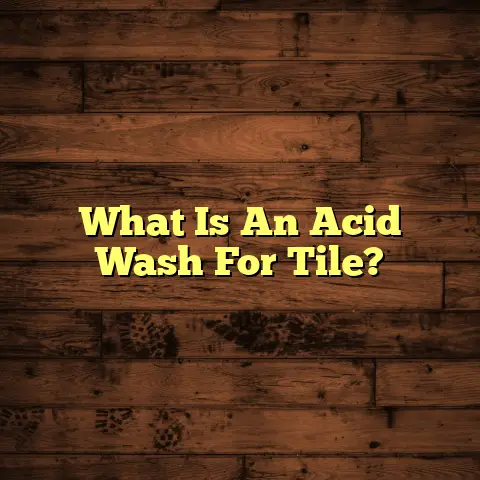Best Non Slip Tile Options? (3 Surfaces To Avoid!)
Ever wondered if that gorgeous, shiny floor you’re eyeing is actually a potential ice rink waiting to happen?
In a world where safety at home is paramount, are you really willing to risk a slip and fall injury for the sake of aesthetics in your flooring choices?
I’m here to tell you, as a flooring contractor with years of experience, that you absolutely don’t have to sacrifice style for safety.
Let’s dive into the world of non-slip tiles and how to pick the perfect ones.
1. Understanding the Importance
of Non-Slip Tiles
So, what exactly are non-slip tiles?
Simply put, they’re tiles designed to provide better traction underfoot, reducing the risk of slips and falls.
Think of it as the difference between wearing ice skates on a frozen pond and wearing hiking boots on a rocky trail.
The hiking boots give you a grip, while the ice skates, well, you get the idea.
Where are Non-Slip Tiles Essential?
Honestly, anywhere in your home where water or moisture is present, or where there’s a higher risk of slipping, non-slip tiles are a lifesaver.
Bathrooms: Obvious, right?
Between showers, baths, and the occasional spilled toothpaste water, bathrooms are slip-and-fall central.-
Kitchens: Spilled sauces, splashed water from the sink, and dropped food can all create hazardous conditions.
-
Outdoor Areas: Patios, pool decks, and walkways are exposed to rain, snow, and ice, making non-slip tiles a must.
-
Entryways: Especially in areas with rain or snow, entryways need that extra grip to prevent accidents.
The Cold, Hard Truth: Slip and
Fall Statistics
You might be thinking, “Okay, slips happen, but are they really that big of a deal?”
Unfortunately, yes.
According to the National Floor Safety
Institute (NFSI), falls account for over
8 million hospital emergency room visits
each year.
(NFSI, n.d.)
And guess what?
A significant portion of these falls occur in the home due to slippery floors.
Specifically, bathrooms and kitchens are high-risk zones.
Think about it: how many times have you almost slipped on a wet bathroom floor?
I know I have, and that’s why I’m so passionate about helping people choose safer flooring options.
2. Factors to Consider When
Choosing Non-Slip Tiles
Alright, so you’re convinced that non-slip tiles are important.
Great! But how do you actually choose the right ones?
It’s not as simple as just picking the roughest-looking tile you can find.
There are a few key factors to consider to ensure you’re getting the best balance of safety and style.
The Coefficient of Friction (COF):
Your New Best Friend
The Coefficient of Friction, or COF, is a measurement of how much resistance a surface offers to an object sliding across it.
In simpler terms, it tells you how slippery a tile is.
The higher the COF, the more grip the tile provides.
The American Society for Testing and Materials (ASTM) has standards for measuring COF.
For level interior surfaces expected
to be walked upon when wet, a static
COF of 0.42 or greater is generally
considered to be safe.
(ASTM D2047)
For exterior surfaces or areas prone to getting very wet, you’ll want an even higher COF.
When you’re shopping for tiles, ask the salesperson for the COF rating.
Don’t be afraid to geek out a little bit – your safety is worth it!
Tile Materials: Not All Created Equal
Different tile materials have different natural slip resistance properties.
Let’s break down some of the most common options:
Ceramic: Ceramic tiles are a popular choice for their affordability and versatility.
However, standard ceramic tiles can be quite slippery, especially when wet.
Look for textured ceramic tiles or those with a matte finish for better grip.-
Porcelain: Porcelain tiles are denser and more durable than ceramic tiles, and they often have better slip resistance.
Textured porcelain tiles are an excellent option for areas prone to moisture.
-
Natural Stone: Natural stone tiles like slate, travertine, and limestone can be beautiful and add a touch of luxury to your home.
However, polished natural stone can be extremely slippery.
Opt for honed or textured finishes for better traction.
-
Vinyl: Vinyl tiles are a budget- friendly and water-resistant option.
Luxury vinyl tile (LVT) and sheet vinyl are available in a variety of textures and patterns, some of which offer good slip resistance.
Always check the COF rating before making a purchase.
-
Rubber: Rubber tiles are naturally slip-resistant and provide excellent cushioning.
They’re a great choice for gyms, playrooms, and other areas where safety is a top priority.
Texture and Surface Finish: The Key
to Traction
The texture and surface finish of a tile play a huge role in its slip resistance.
-
Textured Tiles: Tiles with a rough or uneven surface provide better grip than smooth tiles.
Think of tiles with a slightly raised pattern, a sandy texture, or even a hammered finish.
-
Matte Finish: Matte finish tiles have a non-reflective surface, which helps to increase traction.
They’re a great choice for bathrooms and kitchens.
-
Honed Finish: Honed stone tiles have a smooth, matte finish that provides a good balance of style and slip resistance.
-
Polished Finish: Polished tiles are the most slippery option.
They have a glossy, reflective surface that looks great but offers very little grip, especially when wet.
3. Top Non-Slip Tile Options
Okay, let’s get down to specifics.
Here are some of my favorite non-slip tile options, based on my experience as a flooring contractor:
Option 1: Textured Porcelain Tiles
Textured porcelain tiles are my go-to recommendation for most homeowners.
They offer a fantastic combination of durability, style, and slip resistance.
Benefits:
-
Excellent Slip Resistance: The textured surface provides excellent grip, even when wet.
-
Durability: Porcelain is incredibly durable and can withstand heavy foot traffic.
-
Water Resistance: Porcelain is virtually waterproof, making it ideal for bathrooms, kitchens, and outdoor areas.
-
Variety of Styles: Textured porcelain tiles are available in a wide range of colors, patterns, and sizes, so you can find something that matches your aesthetic.
Aesthetics:
You can find textured porcelain tiles that mimic the look of natural stone, wood, or even concrete.
This allows you to achieve the look you want without sacrificing safety.
Ideal Usage Scenarios:
-
Bathrooms: Shower floors, bathroom floors, and tub surrounds.
-
Kitchens: Kitchen floors and backsplashes.
-
Outdoor Areas: Patios, pool decks, and walkways.
My Personal Experience:
I recently installed textured porcelain tiles in a client’s bathroom, and they were thrilled with the results.
They loved the look of the tiles, and they felt much safer knowing that they were less likely to slip and fall.
Option 2: Rubber Tiles
Rubber tiles are a fantastic option for areas where safety and comfort are top priorities.
Benefits:
-
Superior Slip Resistance: Rubber is naturally slip-resistant, even when wet.
-
Cushioning: Rubber tiles provide excellent cushioning, which can help to reduce fatigue and prevent injuries.
-
Durability: Rubber is incredibly durable and can withstand heavy use.
-
Water Resistance: Rubber is water- resistant, making it suitable for wet environments.
Aesthetics:
Rubber tiles are available in a variety of colors and patterns.
They may not be the most glamorous option, but they’re a practical and safe choice.
Ideal Usage Scenarios:
-
Gyms: Rubber tiles are commonly used in gyms to provide a safe and comfortable surface for exercising.
-
Playrooms: Rubber tiles can help to protect children from falls and injuries in playrooms.
-
Commercial Kitchens: Rubber tiles are often used in commercial kitchens to provide a slip-resistant surface for employees.
My Personal Experience:
I’ve installed rubber tiles in several commercial gyms, and the owners have always been impressed with their durability and slip resistance.
They’re a great investment for any business that wants to prioritize the safety of its customers and employees.
Option 3: Natural Stone with a Honed Finish
If you’re looking for a touch of luxury without sacrificing safety, natural stone with a honed finish is a great option.
Benefits:
-
Natural Beauty: Natural stone tiles add a touch of elegance and sophistication to any space.
-
Durability: Natural stone is incredibly durable and can last for decades with proper care.
-
Slip Resistance (Honed Finish): A honed finish provides a smooth, matte surface that offers good traction.
Aesthetics:
Natural stone tiles are available in a wide range of colors, patterns, and textures.
You can find stone tiles that complement any design style.
Ideal Usage Scenarios:
-
Bathrooms: Bathroom floors and shower walls.
-
Entryways: Entryways and foyers.
-
Living Areas: Living rooms and dining rooms.
My Personal Experience:
I once installed honed limestone tiles in a client’s entryway, and they were absolutely stunning.
The honed finish provided just enough grip to prevent slips, while still allowing the natural beauty of the stone to shine through.
4. Surfaces to Avoid
Now that we’ve covered the best non-slip tile options, let’s talk about the surfaces you should avoid at all costs.
These tiles may look great, but they can be incredibly dangerous, especially when wet.
Surface 1: Glossy Ceramic Tiles
Glossy ceramic tiles are a popular choice for their affordability and shine.
However, they’re also one of the most slippery surfaces you can put in your home.
Why They’re a Poor Choice:
-
Low COF: Glossy ceramic tiles have a very low COF, meaning they offer very little resistance to slipping.
-
Slippery When Wet: When water is present, glossy ceramic tiles become even more slippery.
-
High Risk of Falls: Glossy ceramic tiles are a major contributor to slip and fall accidents in homes.
Real-World Examples:
I’ve seen countless clients who have slipped and fallen on glossy ceramic tiles in their bathrooms.
In one case, a client suffered a serious head injury after slipping on a wet glossy ceramic tile floor.
COF Ratings:
Glossy ceramic tiles typically have a COF of less than 0.40, which is below the recommended level for safety.
Surface 2: Polished Natural Stones
Polished natural stones like marble and granite are often used in high-end homes for their luxurious look.
However, they can be incredibly slippery, especially when wet.
Why They’re a Poor Choice:
-
Low COF: Polished natural stone has a very low COF, similar to glossy ceramic tiles.
-
Slippery When Wet: Water can make polished natural stone even more slippery.
-
Risk of Accidents: Polished natural stone can be a hazard in bathrooms, kitchens, and other areas where water is present.
Potential Accidents:
I’ve heard stories of people slipping and falling on polished marble floors in hotel lobbies and shopping malls.
These falls can result in serious injuries, including broken bones and head trauma.
COF Ratings:
Polished natural stone tiles often have a COF of less than 0.30, which is significantly below the recommended level for safety.
Surface 3: Vinyl Sheets with a Smooth Finish
Vinyl sheets with a smooth finish are a budget-friendly flooring option that is often used in bathrooms and kitchens.
However, they can be surprisingly slippery, especially when wet.
Why They’re a Poor Choice:
-
Smooth Surface: The smooth surface of vinyl sheets offers very little grip.
-
Slippery When Wet: Water can make vinyl sheets even more slippery.
-
Lack of Texture: Vinyl sheets typically lack the texture needed to provide adequate traction.
Slip Hazards:
I’ve seen clients who have slipped and fallen on vinyl sheet flooring in their kitchens after spilling water or food.
These falls can be particularly dangerous for elderly individuals.
COF Ratings:
Vinyl sheets with a smooth finish may have a COF of around 0.40 when dry, but this can drop significantly when wet.
5. Conclusion
Choosing the right flooring is a big decision.
It’s about more than just looks; it’s about creating a safe and comfortable home for you and your family.
I’ve walked you through the importance of non-slip tiles, the factors to consider when choosing them, my top recommendations, and the surfaces you should avoid.
Key Takeaways
-
Safety First: Always prioritize safety when choosing flooring, especially in areas prone to moisture.
-
COF is Key: Pay attention to the Coefficient of Friction (COF) rating of tiles to ensure they provide adequate grip.
-
Texture Matters: Opt for textured or matte finish tiles for better traction.
-
Avoid Slippery Surfaces: Steer clear of glossy ceramic tiles, polished natural stone, and vinyl sheets with a smooth finish.
Your Specific Needs
Remember to consider your specific needs and environment when selecting tile options.
If you have young children or elderly family members, you’ll want to choose tiles with a higher COF.
If you live in an area with frequent rain or snow, you’ll need to choose tiles that can withstand wet conditions.
Safety Should Always Come First
Ultimately, the most important thing is to choose flooring that makes you feel safe and secure in your home.
Don’t be afraid to ask questions, do your research, and consult with a flooring professional to find the perfect non-slip tiles for your needs.
Your safety is worth it!





